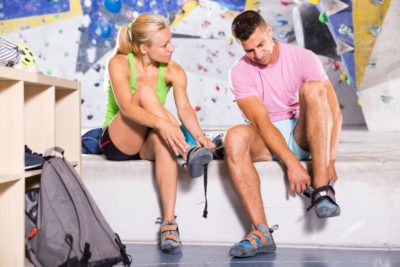When you are just starting out on your bouldering journey, knowing some basic etiquette will help you avoid common blunders.
What are some bouldering gym etiquette basics? Don’t give advice unless it is asked for. Keep yourself and your belongings out of fall zones. Take turns, and don’t interfere with someone else’s wall space. Unless they are falling, don’t touch the person you are spotting.
Your first few times at the bouldering gym can be intimidating, but being aware of some etiquette basics will hugely improve your experience.
Spraying Beta: Why Unsolicited Advice Is Unwelcome
Beta refers to technique or to the specific sequence of moves on a problem. Spraying beta is providing advice or making suggestions on what to do, and what not to do, either on specific holds or on the problem as a whole.
Before saying anything that fits this description, ask the person if they want it before you give it (“Want some beta?”). Especially as a beginner, you may think you’re just having a chat about bouldering, but discussing the merits of a problem and giving instructions on completing it are two different things: “Try putting your foot on the purple foothold there” is spraying beta, while “This problem has some very nice moves” is not.
So mentioning the moves you enjoyed on a particular problem is not spraying beta. It’s perfectly fine to discuss which problems you find fun or challenging. Discussing gear is also not spraying beta.
Why is spraying beta unwelcome? Finding your own beta is like solving a personal puzzle. Having someone solve it for you takes away the satisfaction of figuring it out for yourself. For some people, figuring out their own beta is the most fulfilling part of the sport.
Also, an important part of bouldering is getting psyched, or completely focused, on the problem you are sending. Someone yelling up advice will definitely pull you out of the zone.
Here’s a good rule of thumb: if it wasn’t asked for, it probably isn’t wanted. But if someone asks, suggestions are fair game. Fire away.
“If someone falls on you, it’s YOUR fault.”
This is a popular saying in the climbing world. In the bouldering gym, whether you are climbing or waiting for a turn, it is important to be fully aware of your surroundings. Always be conscious of people around, above and beneath you. Never stand under someone who is on the wall unless you are their spotter.
A related gym etiquette “must” is to keep all belongings – water bottles, shoes, chalk bags – out of potential fall zones and out of the entire padded bouldering area. A water bottle will roll around and can cause a twisted or broken ankle if someone falls onto it. Even a chalk bag, with metal hardware and brushes attached, can cause injury.
Tips to Be a Great Spotter
Spotting is a full topic of its own, but there are a few etiquette-related basics worth mentioning:
- Never touch the person you are spotting while they are climbing. Only touch them if they fall. Some people consider it insulting to be “tagged” by the spotter while they are doing their ascent.
- Keep your focus entirely on the person’s centre of gravity. Don’t allow yourself to get distracted, but do warn people away who drift into the fall zone.
Be a trustworthy spotter. When your partner falls, you should quickly step in and guide their head and back to a safe landing, and absorb some of the force of the fall. Many spotters will instead jump back out of the way. If you will be spotting, it’s important to learn proper technique and to do it right.
Taking Turns at the Bouldering Wall
People are expected to take turns on the bouldering wall. If someone is on a problem that you want to send, the person already on the wall has the right of way. Wait until they are finished before taking your turn. When it looks like the wall is free, it’s fine to jump on.
If the gym is not busy, do a quick look around to make sure you’re not cutting in front of someone else.
Don’t get on the wall while someone is putting their brush away after cleaning off the holds. They will have done the cleaning to get better feel on the holds, and it is bad etiquette to jump on ahead of them.
When your turn comes, if you’re still trying to figure out how to approach the problem, take a step back and let someone else have a go while you’re planning your moves.
Beware of wall hogging. If you fall off, let someone else have a go. If you fall off on the first move, it’s usually fine to get back on if you’re quick about it. However, you don’t want to be that person who falls off and gets right back on five or six times, annoying everyone who is waiting.
When there are several people standing around looking at a problem, chances are good that they waiting to get on the wall. They may even be courteously trying to figure out whose turn it is, so it would be bad etiquette to step in ahead of them. There may not be a proper lineup, so you will need to keep track of who was already there when you arrived. If there’s an obvious opportunity to get on the wall and no-one takes it, it’s fine to ask if you can get on.
If you are having problems with getting your turns, you may need to be clearer with your body language. Make it obvious that you are next in line by standing, facing the wall, and chalking up. Make a point of looking like you’re ready. Claiming your turn is much more effective than waiting for others to let you have it.
If someone jumps in ahead of you, go ahead and let them know that you have been waiting for the wall to be clear. Sometimes, people are not intentionally jumping queue. They are just superbly unaware.
All that being said, there’s usually no problem with getting a fair turn at the wall.
Avoid Interfering with Someone Else’s Bouldering Space
When you start a problem, make sure you will not interfere with anyone who is already on the wall. This is a common oversight. Not all problems go straight up, and some people will be traversing. If their feet are already off the ground before you get on, it’s up to you to make sure that your route will not intersect with theirs. See where other people’s problems are headed. If they come close to or cross yours, you should wait until they have finished their attempt.
It’s perfectly fine to use holds that are not on the official problem you are sending, it is not necessary to follow a set route exactly. But if you wander too far off, you will confuse people who are waiting for an opening to start their turn. Try to stay reasonably close to the route setter’s original intent.
If you are already on the wall and someone starts a problem that will intersect with yours, let them know. They may not have noticed you.
Quick Etiquette Tips on Chalk Use
No article on bouldering gym etiquette would be complete without mentioning the almost universal use of chalk. Most chalk etiquette relates to keeping it contained and preventing dust clouds. Here, briefly, are some basic tips on chalk use in the gym:
- Don’t get so much chalk on your hands that you need to blow most of it off
- If you leave a lot of chalk on holds, brush it off after you finish the problem
- Try to keep your chalk from spilling on the floor
Using a chalk ball instead of loose chalk takes care of most of these situations. For information on choosing your first type of chalk, click here.
More Etiquette Tips for Safe and Smooth Bouldering
In bouldering gyms, etiquette and safety are often intertwined. Here are some important examples:
- Never move a crash pad without first checking that it’s not already being used. If there are people near it and no-one is on the wall, ask before moving it.
- If you find a hold that spins or feels loose, tell the gym staff so it can be fixed before anyone else gets on the problem.
- If you wear headphones, keep the volume low enough to know what’s going on around you. If someone yells that they’re about to fall on you, you want to hear it.
- If you bring kids to the gym, keep them contained and supervised. It is potentially very dangerous if they run underneath someone who is on the wall.
Other etiquette tips are more about being considerate to your fellow bouldering enthusiasts:
- While being vocal can actually help with a difficult move, “boulder banshees” who yell and groan at every move are distracting to those who would like to concentrate on their own ascent.
- Some family-oriented gyms have rules against swearing. If a nasty word slips out, quickly apologize and then get on with your problem.
- Going barefoot is usually strongly discouraged. Wear flip-fops or climbing shoes, depending on where you are in the gym.
- Don’t pause to take selfies on the wall when the gym is busy.
Final Thoughts on Bouldering Gym Etiquette
That turned out to be a lot of tips, but I hope that they will provide you with a great start in making your bouldering journey a smoother experience.

